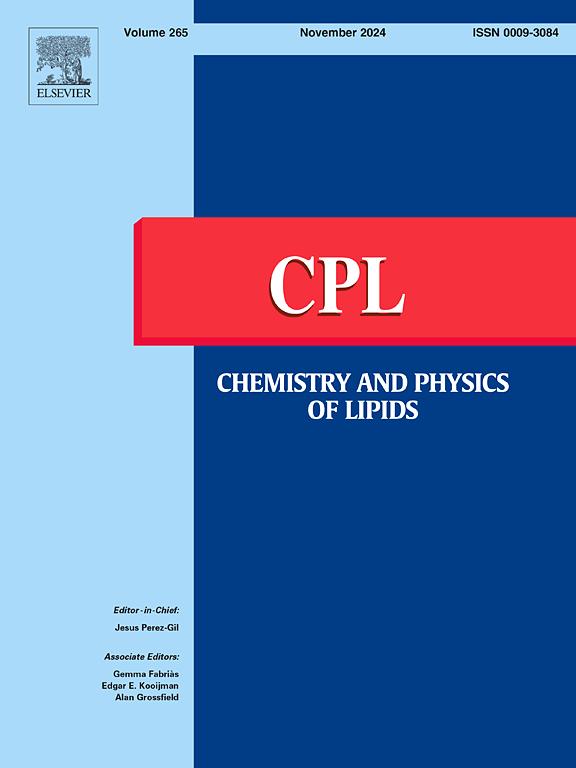Location and dynamics of astaxanthin in the membrane
IF 2.8
3区 生物学
Q2 BIOCHEMISTRY & MOLECULAR BIOLOGY
引用次数: 0
Abstract
Astaxanthin (ASX) is a natural xanthophyll carotenoid recognized for its strong antioxidant bioactive function, and it has been used in the prevention of heart disease, inflammation, neurological disorders, scavenger of environmental produced free radicals and as an anti-aging and anti-cancer biomolecule. ASX is a long lipophilic molecule with two terminal relatively polar rings connected by a long hydrophobic chain. This work describes the dynamics, orientation, location and interactions of ASX in a complex biomembrane. In water, ASX form high-order aggregates where the molecules are joined together by the hydrophobic chain. Depending on the number of ASX molecules, the aggregates can have different structures and the polar groups positioned superficially contacting the solvent. ASX molecules are not able to insert themselves into the membrane, forming high-order aggregates quickly. In the membrane, ASX molecules do not aggregate, remaining all time in the monomeric state. ASX is capable of reaching both membrane surfaces, one at a time. The ASX molecules form an approximate angle of 20º with respect to the membrane perpendicular and it is inserted between the phospholipid hydrocarbon chains, increasing slightly the membrane fluidity. ASX is readily miscible with membrane phospholipids and its location within the membrane is suited for its potent antioxidant activity. Furthermore, since ASX has two polar groups at both ends, the molecule can function in a wide range of depths. ASX is therefore perfectly suited for its antioxidant task in the membrane.
虾青素在膜中的位置和动态。
虾青素(Astaxanthin, ASX)是一种天然的类胡萝卜素类叶黄素,具有较强的抗氧化活性,被广泛应用于预防心脏病、炎症、神经系统疾病、清除环境产生的自由基以及抗衰老、抗癌等生物分子。ASX是一种长亲脂分子,具有两个末端相对极性的环,由一条长疏水链连接。这项工作描述了动态,取向,位置和相互作用的ASX在一个复杂的生物膜。在水中,ASX形成高阶聚集体,其中分子通过疏水链连接在一起。根据ASX分子的数量,聚集体可以有不同的结构和极性基团定位在与溶剂接触的表面。ASX分子不能将自己插入到膜中,迅速形成高阶聚集体。在膜中,ASX分子不聚集,一直保持单体状态。ASX能够到达膜的两个表面,一次一个。ASX分子与膜垂直形成约20º的夹角,并插入磷脂烃链之间,略微增加膜的流动性。ASX很容易与膜磷脂混溶,其在膜内的位置适合其强大的抗氧化活性。此外,由于ASX在两端有两个极性基团,该分子可以在很宽的深度范围内发挥作用。因此,ASX非常适合其在膜中的抗氧化任务。
本文章由计算机程序翻译,如有差异,请以英文原文为准。
求助全文
约1分钟内获得全文
求助全文
来源期刊

Chemistry and Physics of Lipids
生物-生化与分子生物学
CiteScore
7.60
自引率
2.90%
发文量
50
审稿时长
40 days
期刊介绍:
Chemistry and Physics of Lipids publishes research papers and review articles on chemical and physical aspects of lipids with primary emphasis on the relationship of these properties to biological functions and to biomedical applications.
Accordingly, the journal covers: advances in synthetic and analytical lipid methodology; mass-spectrometry of lipids; chemical and physical characterisation of isolated structures; thermodynamics, phase behaviour, topology and dynamics of lipid assemblies; physicochemical studies into lipid-lipid and lipid-protein interactions in lipoproteins and in natural and model membranes; movement of lipids within, across and between membranes; intracellular lipid transfer; structure-function relationships and the nature of lipid-derived second messengers; chemical, physical and functional alterations of lipids induced by free radicals; enzymatic and non-enzymatic mechanisms of lipid peroxidation in cells, tissues, biofluids; oxidative lipidomics; and the role of lipids in the regulation of membrane-dependent biological processes.
 求助内容:
求助内容: 应助结果提醒方式:
应助结果提醒方式:


